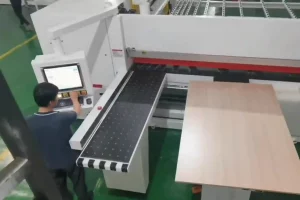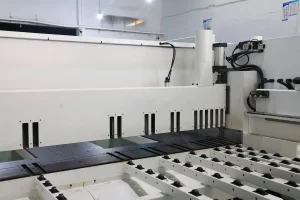
Optimizing Cut Efficiency in Steel Beam Cutting Saw Operations
https://panel-saw.com/panel-saws/The precision and efficiency of steel beam cutting are vital aspects of modern construction and infrastructure projects. To achieve optimal results, steel beam cutting saw technologies must be optimized to ensure both high-quality cuts and increased productivity. This article delves into the key aspects of optimizing cut quality and efficiency in steel beam cutting saw operations.
Understanding the Role of Blade Selection in Steel Beam Cutting Saw Efficiency
Introduction: Importance of Blade Selection
Blade selection is a critical factor in determining the quality and efficiency of cuts made by steel beam cutting saws. The right blade can significantly enhance the performance of the saw, resulting in precise and clean cuts. Conversely, an inappropriate blade choice can lead to poor cut quality and reduced productivity.
Blade Types and Their Applications
Modern steel beam cutting saws utilize a variety of blades, each designed for specific cutting needs. General-purpose blades with medium tooth pitch are ideal for straight cuts in mild steel beams. For more challenging cuts, such as those involving thicker or harder materials, blades with finer tooth pitches and increased mass are recommended. These blades offer greater durability and precision, ensuring that the cutting process is both efficient and accurate.
Conclusion: Optimizing Blade Selection
In conclusion, selecting the appropriate blade for the material and cutting requirements is essential for optimizing the performance of steel beam cutting saws. By choosing the right blade, contractors can ensure high-quality cuts and enhance overall productivity.
The Impact of Feed Rate on Steel Beam Cutting Saw Performance
Introduction: Balancing Speed and Precision
The feed rate, or the speed at which the beam is moved through the saw, plays a significant role in the cutting process. Balancing speed and precision is crucial to achieving optimal results in steel beam cutting saw operations.
Factors Influencing Feed Rate
A slow feed rate provides greater control and precision, making it suitable for delicate or intricate cuts. However, it also results in slower cutting times, which can affect productivity. On the other hand, a fast feed rate can significantly increase productivity but may compromise accuracy and cut quality. The optimal feed rate depends on various factors, including the material being cut and the type of blade used.
Conclusion: Optimizing Feed Rate for Best Results
In conclusion, finding the right balance between speed and precision is key to optimizing feed rates in steel beam cutting saw operations. By carefully adjusting the feed rate based on the specific cutting requirements, operators can achieve high-quality cuts while maintaining productivity.
Coolant Usage and Its Role in Steel Beam Cutting Saw Efficiency
Introduction: Importance of Coolant in Cutting Operations
Coolant plays a vital role in the cutting process by reducing heat generation and preventing heat-affected zones (HAZ). Proper coolant usage can significantly enhance the performance and longevity of steel beam cutting saws.
Types of Coolant and Application Methods
There are various types of coolants available, each suited for different cutting applications. Coolants help to reduce the temperature of the cut surface, resulting in improved surface finish and reduced risk of cracking. The application method, whether it be through flood coolant systems or mist cooling, also affects the effectiveness of the coolant. Selecting the appropriate type of coolant and application method is crucial for achieving optimal results.
Conclusion: Enhancing Performance with Proper Coolant Usage
In conclusion, proper coolant usage is essential for optimizing the efficiency and quality of steel beam cutting saw operations. By choosing the right coolant and application method, operators can enhance the performance of their cutting saws and extend the lifespan of their blades.
Maintenance and Inspection for Optimal Steel Beam Cutting Saw Performance
Introduction: The Need for Regular Maintenance
Maintaining the integrity of a steel beam cutting saw’s components is crucial for ensuring optimal performance. Regular inspection and maintenance schedules should be established to keep the saw’s blades, motor, and other moving parts functioning properly.
Key Maintenance Practices
Proper lubrication and tensioning of the blades are essential to prevent vibration and ensure accurate cuts. Regularly checking the saw’s components for wear and tear can help prevent unexpected breakdowns and maintain the efficiency of the cutting process. Establishing a routine maintenance schedule can significantly improve the longevity and reliability of steel beam cutting saws.
Conclusion: The Importance of Maintenance
In conclusion, regular maintenance and inspection are vital for maintaining the performance and efficiency of steel beam cutting saws. By adhering to a routine maintenance schedule, operators can ensure high-quality cuts and prolong the lifespan of their equipment.
Summary
Optimizing cut quality and efficiency in steel beam cutting saw operations requires careful consideration of several key factors. Selecting the appropriate blade for the material and cutting requirements is crucial for achieving high-quality cuts. Balancing the feed rate to ensure both speed and precision can enhance productivity without compromising accuracy. Proper coolant usage is essential for reducing heat generation and preventing heat-affected zones, thus improving the surface finish and blade lifespan. Finally, regular maintenance and inspection of the saw’s components are vital for maintaining optimal performance and extending the equipment’s lifespan. By focusing on these aspects, contractors and fabricators can significantly improve the efficiency and quality of their steel beam cutting operations.
FAQ
1. Why is blade selection important in steel beam cutting saw operations? Blade selection is crucial because the right blade can enhance the performance of the saw, resulting in precise and clean cuts. An inappropriate blade can lead to poor cut quality and reduced productivity.
2. How does feed rate affect the performance of a steel beam cutting saw? The feed rate impacts both the speed and precision of the cutting process. A slow feed rate provides greater control but slower cutting times, while a fast feed rate increases productivity but may compromise accuracy.
3. What role does coolant play in steel beam cutting saw operations? Coolant reduces heat generation, prevents heat-affected zones, improves surface finish, and extends blade life. Proper coolant usage is essential for optimizing the efficiency and quality of the cutting process.
4. What maintenance practices are important for steel beam cutting saws? Regular inspection and maintenance of the saw’s components, proper lubrication and tensioning of the blades, and establishing a routine maintenance schedule are key practices for maintaining optimal performance and extending the lifespan of the equipment.
5. How can I optimize the performance of my steel beam cutting saw? To optimize performance, select the appropriate blade for the material, balance the feed rate for speed and precision, use the right type and application method of coolant, and adhere to a regular maintenance and inspection schedule.



















